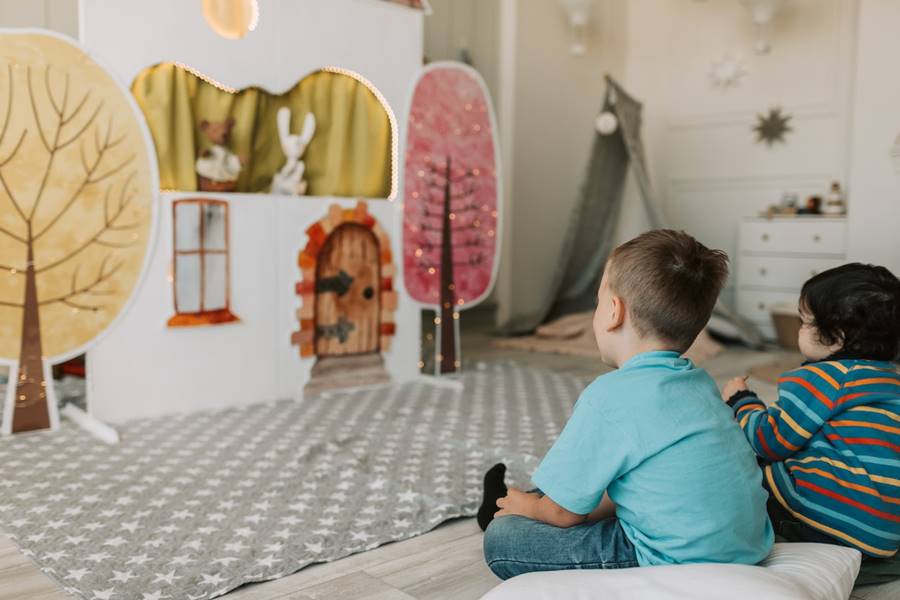
By Jae-Ha Kim
Chicago Sun-Times
May 5, 2002
Cultured children. They are the ones clutching their ballet programs, clapping politely after the end of a particularly beautiful pas de deux. They know about Van Gogh’s art as much as they do the legend of his severed ear. And when they go through their CD collection, they have as much Bach and Beethoven as they do Britney.
Where do these kids come from? Are they born, or cultivated? And, more important, how do you ensure that your child will grow up to be one of them?
It takes work, because culture doesn’t happen by osmosis. But those of you who neglected to recite sonnets to your unborn baby needn’t fear. We can help with a step-by-step guide to raising a culturally aware child.
But before you spring for season tickets to the symphony or ballet, gauge your child’s interest. Baby steps aren’t such a bad thing when you’re dealing with, well, babies.
For the little ones, check out “The Baby Einstein Company” series of pre-school videos and DVDs aimed at baby artists in training. The series–which includes “Baby Mozart,” “Baby Van Gogh” and “Baby Shakespeare” ($14.99 on video; $19.99 on DVD)–introduces babies to language, music, art and poetry.
DANCE
Introduction: Ballet, tap or modern dance lessons. A trip to see a performance of “The Nutcracker.”
The next step: Ah yes, the next step. You can only take your child to see “The Nutcracker” so many times before he or she gets bored.
“Children like to move,” says Carla Graham-White, outreach and education coordinator for the Joffrey Ballet. “But you don’t have to enroll children in ballet classes to get them interested in dance. Any creative movement class, such as gymnastics or figure skating, encourages a child’s imagination. And folk dancing is a way for children to get in touch with different cultures while they’re learning about movement.”
Gaby Rocha, 13, has been taking Mexican Folkloric dance lessons for the last three years. She has also studied ballet, tap and jazz.
“I’ve always been interested in the arts,” says the Northwest Side eighth-grader, who says she doesn’t find it weird to enjoy both classical music as well as the pop sounds of Shakira and Alicia Keys. “My mom took me to see a lot of plays when I was about 8-years-old and I really loved it.”
Her stepfather, Matt Smith, adds, “My wife, Elvira, has always made it a point to take Gaby along to culturally educational events. We’ve taken Gaby to the Lyric Opera, to the Shakespeare Theater at Navy Pier and to London, where Gaby had tea at Harrods. We toured the Louvre and Notre Dame in France. And one of the things Elvira is insistent on is having her take Latin as her foreign language class.”
Gaby notes that math, not Latin, is her favorite subject.
“Most of my friends are into more traditional teenage things,” says Gaby. “I like those, too, but I also really like going to see different types of arts. It’s like learning, only more fun.”
Graham-White says one way to make dance more fun for children is to prepare them prior to a performance.
“Go to the library and let them listen to the music they’re going to hear at the ballet,” she suggests. “Or check out a performance on television if they’re airing a similar program. You want to make dance accessible to kids or they’re not going to be interested.
The Joffrey prepares middle school students to the arts by working with schools.
“We try to take away the intimidation of going to see dance by teaching kids little things like when to clap and the difference between saying ‘bravo’ and ‘brava,’ ” says Graham-White. “Our dancers also go into the schools and talk to the students. You can always tell when our kids are in the audience ’cause they’re always cheering extra hard for the dancers they’ve already met.”
And about that bravo/brava thing, the first is exclaimed for male performers, the latter for female.
More info: The Joffrey, (312) 739-0120 or www.joffrey.com
VISUAL ARTS
Introduction: Finger painting. Park exhibits. Drawing classes.
The next step: Art has a reputation for being inaccessible and often times incomprehensible. But the fact is that we deal with art on a daily basis, whether it’s decorating a poster for a friend’s birthday or picking out a gorgeous dress pattern.
The Art Institute of Chicago is doing its part to de-mystify art.
“There’s no mystery to art,” says Jean Sousa, associate director of museum education at the Art Institute. “But there is an old perception that a museum is like a temple. Art museums are particularly prone to this misunderstanding because they’re not interactive like science museums. People also think they have to have art history degrees to be able to enjoy art and explain it to their children. But it’s really all about exposure.”
It helps if parents are savvy in connecting a child’s interest to an art.
“To get my son–now 14–interested in the Art Institute, I took him to see the armor display in the main hall,” says Gina Hammarlund of Gurnee. “After each visit, we would stop at a Thai restaurant nearby. [Getting children
interested in the arts] starts when they are young. Now we routinely attend the exhibits.”
Forget about your own fears of not knowing the difference between Monet and Manet. Check out the museum’s family-oriented activities. Let the little ones meet Artie the Lion, and introduce the older children to Julian the Time Traveler, who visits different eras and cultures.
It doesn’t have to be expensive, either. For the last 20 years, the Art Institute has hosted free family workshops every weekend.
More info: The Art Institute of Chicago, (312) 857-7161 or www.artic.edu
CLASSICAL MUSIC
Introduction: Music lessons. Taking them to see a musical on stage or a neighborhood jazz fest.
The next step: If you think children won’t like any type of music besides pop or rock, then they probably won’t. So take a pro-active stance and expose your child to classical, jazz, roots rock, folk and opera in addition to the pop and rock they’ll probably discover on their own.
Opera star Jessye Norman says she was stunned when a group of tweens–not the usual demographic of her fans– approached her in New York City.
“One of them came up to me and said, ‘I’ll bet you think we don’t know who you are,'” Norman says, laughing. “Honestly, I didn’t expect them to. One has to understand that when opera began, it was a popular art form. It’s only considered elitist these days by people who haven’t given it a chance. I speak widely about arts education. It’s so very important to have kids exposed to things early, because once they’re exposed to it, they’re all right with it. It’s not a punishment anymore.”
The Chicago Symphony Orchestra offers a number of concert series aimed at children. To keep their attention span, they employ puppets, mimes and dancers to complement the music being performed.
“We keep the concerts to about 50 minutes long, which is just enough for a child,” says Charlie Grode, the CSO’s director of education. “We want the kids to see how fun classical music can be. This introduces children to stringed instruments, which may encourage them to learn to play the violin or cello. The great thing about children is they have no fear. They have less tension in their bodies than adults do and they have no preconceived notions about having to sound like Yo-Yo Ma. They just want to have fun.”
Annalee Letchinger and her husband, David Hoppe, raised all five of their children, ranging in age from 9 to 23 years old, to appreciate the arts. Each child plays the piano and a stringed instrument.
“There has been different kinds of resistance from our kids to their lessons,” says Letchinger, whose family resides in Rogers Park. “But my husband is a wonderful motivator. He wrote music for our three youngest children to play together. They participate in a competition as a trio and seem to get a kick out of it.”
It’s not always easy for a family of seven to attend cultural events together, but a little ingenuity helps get the job done. Besides the four annual concerts they attend at the CSO, they also look for dress rehearsals and local performances that may be free.
“During the summer, we sometimes get free tickets to Ravinia through the public libraries,” says Letchinger. “The kids love it. They can roll around on the grass while listening to the beautiful music. Our kids are well behaved at performances because they’ve been going all their lives. But it’s fun for them to be able to behave like kids.”
Fourth-grader Ethan Hoppe says he enjoys his music lessons as much as he does playing midfield and goalie on his soccer team.
“I’m thinking about becoming a musician when I grow up,” says Ethan, who has been playing the piano for three years and the violin for five. “I’m not sure yet. I like a lot of things.”
For those who can’t afford private music lessons, check with various community music schools, some of which offer scholarships or free lessons.
More info: CSO, (312) 294-3452 or www.cso.org
THEATER
Introduction: Puppet shows. School plays.
The next step: To be or not to be. An actor, that is. That is not the question. Introduce your children early on to the world of live theater and you’re giving them a jump start on appreciating literature and the power of words. Some, like artists Chris and Diane Wilson, believe you’re never too young for theatre.
“We recently took [our 3-year-old daughter] Haley to the ‘Little Mermaid’ at the Drury Lane,” says Diane Wilson of the Gold Coast. “She enjoyed the show despite it being very different from the Disney adaptation. The cast gave a question and answer session after the show and Haley asked a question, which led to an explanation about adaptations. She came home and immediately wanted me to read the Hans Christian Anderson version to her.”
The Wilsons make theater accessible to Haley by incorporating it into their lives. For her first birthday, she celebrated with a theatre party at the Players Workshop Children’s Show. For her third birthday, they had her soiree at the Apollo Theatre, where they saw a production of “Winnie the Pooh.”
“She had about 25 friends and their families there and we had a party on the stage for her afterward where the characters all came for a visit, photos, autographs and games,” says Wilson. “The kids all enjoyed it, as did many of the adults.”
Char Rapoport Nance adds that her 13-year-old son Michael has been attending performances at the Drury Lane Theatre since he was 6.
“We started going to plays with him when he was 3,” says Nance, of Highland Park. “He sings in the school chorus and the boys ensemble and goes to a fine arts camp in Michigan. He does improv and also acts.”
Both sets of parents agree that balance is key.
“We’ve tried hard not to exclude sports and other interests he has, like in science and history,” says Nance.
The prime goal at the Steppenwolf is to keep the kids coming back, according to Hallie Gordon, director of the Steppenwolf Arts Exchange Program.
“It’s a very fine balance to presenting children with a show that is not above or below them,” she says. “We do two productions each year that are geared for middle school and high school students. “For our opening season, we’re going to do ‘Fahrenheit 451,’ which is on the Chicago Public School reading list.They can read the book and then go see it performed live and later talk about the differences between the two formats. We try to bring everything full circle.”
Steppenwolf also counts on its Teen Crosstown Ensemble, composed of a group of 15 children who are invited to workshop a play. Unfortunately, the waiting list is long for the free program.
“Next year we’re pairing these teens with mentors,” Gordon says. “It’ll be a great experience for the kids to work with them in the workshop and then go to cultural events or out for coffee with an artist who’s an adult, but not an authority figure.”
And lest you think only Chicagoans have access to great theater, don’t forget that the Steppenwolf started in a Highland Park church basement.
In other words, seek out theater at park districts, churches, schools and recreational centers.
More info: Steppenwolf, (312) 335-1888 or www.steppenwolf.org





